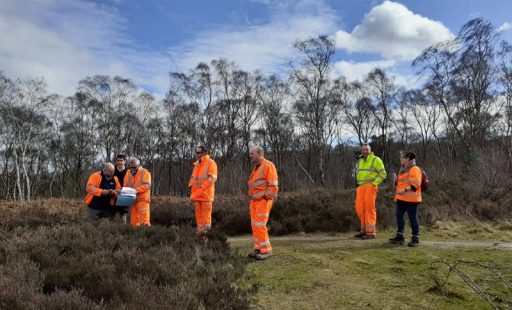Rugeley quarry have worked in partnership to develop Heathland management plan, to bring their adjoining land, SSSI and part of the Special Area of Conservation (SAC) back into favourable condition.
CEMEX Rugeley quarry is a sand and gravel site on the edge of Birmingham, situated next to SSSI site Bevin’s Birches. The site is being restored to heathland which is a high priority habitat for the area. Wildlife such as the Adder, Grass Snake and Common Lizard, as well as rare and red listed birds such as the Dartford Warbler, Nightjar and Woodlark all benefit from this kind of habitat. Once restored the site will form part of a wider network of heath and woodland mosaics that includes Cannock Chase.
Overtime the site has become dominated by bracken and bramble with scrub starting to encroach, without undertaking vital management the heathland would be lost, and these priority species will lose their home.
 A site visit to Rugeley took place in early March, before physical distancing, with Alex Finn from the CEMEX Restoration Team; Gareth Fenna, Quarry Manager; Jenny Oldroyd, RSPB Partnership Advisor; Jaclyn Lake, Natural England; and Wesley Parnell, RSPB heathland management team, to make an initial overview assessment of the heath’s management needs. It was a really positive visit with all parties keen to work together. The weather was kind and the warm spring sunshine gave some great wildlife sightings too, with Woodlark calling, Goshawk seen and even Adder giving us a hiss, as we accidentally disturbed it, before sliding off and vanishing under the bracken.
A site visit to Rugeley took place in early March, before physical distancing, with Alex Finn from the CEMEX Restoration Team; Gareth Fenna, Quarry Manager; Jenny Oldroyd, RSPB Partnership Advisor; Jaclyn Lake, Natural England; and Wesley Parnell, RSPB heathland management team, to make an initial overview assessment of the heath’s management needs. It was a really positive visit with all parties keen to work together. The weather was kind and the warm spring sunshine gave some great wildlife sightings too, with Woodlark calling, Goshawk seen and even Adder giving us a hiss, as we accidentally disturbed it, before sliding off and vanishing under the bracken.
CEMEX are working in-partnership with the RSPB, and liaising with Natural England, to pull together a plan to manage the adjacent land that is part of the SAC. This plan will be a long-term commitment by CEMEX, the vision is to bring back a more diverse structure to the heath, reduce bracken cover and manage scrub. This is going to be challenging in such an open area. With the first phase being a survey to identify which areas to prioritise management and to identify wildlife that use the site. After which a management plan will be drafted, and the vital management work started.
Photo credit: Dartford Warbler taken by Tim Melling.
